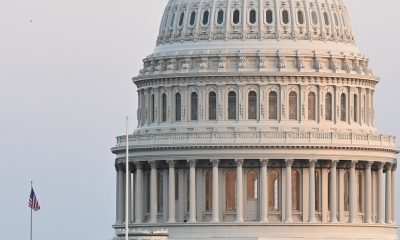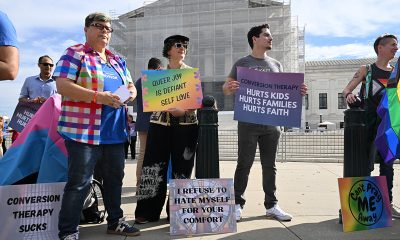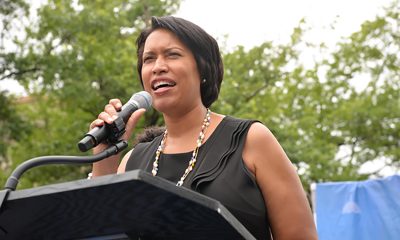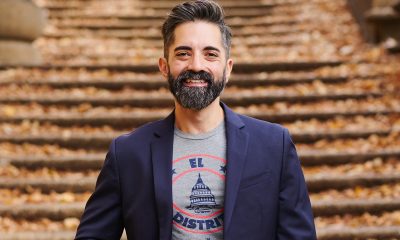Opinions
Johnny Depp, Amber Heard and the deeply unsatisfying matter of re-litigating their trial
The series was panned by critics

On Aug. 16, Netflix released a three-part docuseries revisiting last summer’s televised civil litigation over allegations that Amber Heard had defamed ex-husband Johnny Depp by claiming to have survived sexual violence and domestic abuse during their four-year relationship.
Rather than offering anything new by way of insight or analysis from anyone with relevant qualifications or experience, each episode features clips from some of the online “creators” who turned their hot takes on the trial into a veritable cottage industry of amateur legal commentary and courtroom conspiracy theories, feeding the rapacious demand for anti-Heard and pro-Depp content. (As if to underscore the project’s unseriousness, these included a men’s rights YouTuber who wore a Deadpool mask and was surrounded by Spider-Man costumes.)
Worse still, “Depp v. Heard” director Emma Cooper fails not only to answer but also to even ask the obvious questions that have lingered since a verdict was returned more than 14 months ago by seven jurors in northern Virginia who were not sequestered as the case became, by far, the most popular topic on social media and online platforms.
At the same time, however, the episodes include footage of courtroom testimony that offer a glimpse, though incomplete, into some of the trial’s more salient and dispositive moments that I otherwise would never have seen (with neither the time nor the inclination, either last year or now, to follow 120+ hours of argument by the parties presented over the course of a seven-week trial.)
Do these scenes redeem the series? Hardly. But that does not mean they offer nothing of value, especially considering that while this was not the retelling of last summer’s events that we deserve, it remains the only one we’ve got. At least, for now.
Susan Sontag, in her 1977 collection of essays “On Photography,” proclaimed “The camera makes everyone a tourist in other people’s reality, and eventually in one’s own.”
In “Depp v. Heard,” the cameras facilitate a very specific kind of tourism that feels both exploitative and voyeuristic, because the reality in which we find ourselves trespassing is dark: the unraveling of a relationship between movie stars through patterns of dysfunction and abuse both familiar and alien, knowable and unknowable, like a city you have visited but never called home.
Especially when coupled with the more outrageous moments from trial that made headlines at the time – such as the debate over whether Heard defecated on Depp’s bed and blamed his teacup Yorkshire Terrier – there is a temptation to treat footage of testimony concerning the smashing of liquor bottles and hurling of wine glasses, the shoving and taunting and threats, even the physical and sexual violence, as though it were pure spectacle.
However, this would suggest, wrongly, that the painful realities of the actors’ relationship are so far removed from our lived experiences that we do not, cannot, or should not relate to them. As if a seven-week trial adjudicating the conflicts in our own intimate relationships or those involving the people we love would not turn up evidence of trouble and dysfunction, or worse.
Considering that we are primed to pick winners and losers and heroes and villains, perhaps it was unsurprising that incomplete and selectively edited footage from the case provided ample fodder for Instagram reels and TikTok videos that were created in the service of narratives that, most often, favored Depp and vilified Heard.
For me, witnessing these scenes in their proper context revealed a picture so much more complicated and, frankly, ugly that the prospect of framing the case in this manner seemed as preposterous as the idea that audiences leaving a production of “Who’s Afraid of Virginia Woolf” should find themselves allied with either Martha or George.
To take just one example: From the witness stand, Heard recounted how she would often return home to their shared Los Angeles penthouse to find Depp nodding off in a chair because he had washed Roxicodone down with whiskey, or lying supine on the sofa fully unconscious with melted ice cream pooled in his lap. Worried about her husband’s apparent substance use disorder and unsure how best to help, the actress admitted she would sometimes take photos of him and share the pictures with a trusted friend.
Or, Depp’s attorney asked, was she just trying to humiliate him? Or, online commentators asked (often rhetorically), was this a calculated and premeditated move to collect evidence she would use against Depp in litigation or for purposes of extorting him?
As if these motives are mutually exclusive.
Having experienced the pain of watching loved ones spiraling in the throes of drug and alcohol addiction, I can tell you why I suspect Heard took the photos, but of course the reality is neither I nor anyone else – perhaps not even she – has any clue.
Last year, so much of the online noise about the trial came from content creators who made specious arguments to poke holes in the credibility of Heard’s testimony or alleged ulterior, sinister hidden motives based on the actress’s countenance, demeanor, speech, and other behavior.
For example, in clips that were often selectively edited or presented outside of their proper context, Heard might have seemed to cry more hysterically upon realizing the cameras were trained on her, which were used as supposed proof that her claims of suffering abuse at the hands of her ex-husband must therefore be fabricated.
Watching the footage in the manner presented on screen in “Depp v. Heard,” it becomes even more obvious how silly these interpretations were. In reality, of course, no one – not even police officers, trial court judges, F.B.I. and C.I.A. agents, trial lawyers or forensic psychiatrists – can reliably spot when someone is lying to them.
However convincing some YouTuber may have been, and however comforting the idea that we are able to see through the lies of others, I’m sorry to tell you the research on this is overwhelming and uncontested.
As Malcolm Gladwell observes in “Talking to Strangers,” Amanda Knox was falsely convicted for a murder she did not commit because “much of the prosecution’s case…rested on the allegedly strange, guilty behavior she exhibited,” which “the public deemed not in line with typical responses to grief and trauma.”
The cameras did not tell the complete story.
Well before 2022, private details about Depp and Heard’s troubled relationship had spilled onto the pages of tabloids like The Sun, which called Depp a “wife beater” in a 2018 story alleging that “overwhelming evidence was filed to show Johnny Depp engaged in domestic violence against his wife.” After he sued the paper for defamation, London’s High Court of Justice ruled against the actor in 2020, concluding the claims at issue were “substantially true.”
Still, last summer’s litigation between the actors earned far more public attention and unearthed far more (and far more titillating) private information, causing, therefore, far more damage than the supermarket rags and gossip blogs – as well as, ironically, the financial and reputational damage resulting from the very defamation claims that were adjudicated at trial.
As a reminder, Depp sued his ex-wife for a 2018 opinion article in the Washington Post in which she had written, “two years ago, I became a public figure representing domestic abuse, and I felt the full force of our culture’s wrath for women who speak out.” Heard was referencing the backlash against, essentially, identical claims she made in a statement after securing a restraining order against Depp following their divorce in 2016. (“During the entirety of our relationship, Johnny has been verbally and physically abusive to me,” she wrote.)
In so many cases including this one, intimate partner abuse is messy. An audio recording of one of the couple’s arguments shows Heard acknowledging she had struck her ex-husband but denying that she punched him. Her testimony, meanwhile, detailed serious violent crimes, including that Depp had thrown her into a ping pong table and repeatedly hit her in the face before sexually assaulting her with a liquor bottle that may have been broken.
Of course, assuming their sworn testimony to be true, it must also be said, domestic violence is a gendered crime. And the imbalanced power dynamics within their relationship put Heard at a disadvantage, including in this respect. While both are famous actors, the wealth, power, and fame wielded by Depp was then (and remains, now) much greater.
The disparity was evident from the outset. In the Netflix series, throngs of fans are shown cheering the Pirates of the Caribbean star and booing Heard on the first day they were sighted arriving separately to the Fairfax County Circuit Court. Meanwhile, online, evidence of a sustained and coordinated character assassination of Heard had just begun to emerge.
The smear campaign would persist through the trial and beyond. The actress was called a manipulative liar, a gold digger, an abuser, a violent psychopath, a drug addict, and worse. Some of the most outrageous claims were among the most widely circulated: She snorted cocaine on the witness stand, killed her own mother to conceal testimony that would have exonerated Depp, plagiarized lines from the film The Talented Mr. Ripley.
Creators mocked Heard by lip-synching over audio of her testimony about suffering violent abuse in videos that went viral on TikTok along with hashtags like #JusticeForJohnnyDepp, which was seen nearly 3 billion times on the platform. (#justiceforamberheard earned just 25 million views.) One-sided articles and videos, many containing false and misleading claims, were promoted by Ben Shapiro’s conservative media outlet The Daily Wire through its estimated $35,000 and $47,000 purchase of Facebook and Instagram ads.
“Depp v. Heard” was panned by critics.
“If ever a true-crime documentary needed the usual collection of talking-head interviews with esteemed journalists, law enforcement veterans and legal experts to put things in perspective,” Richard Roeper of the Chicago Sun Times wrote, “this is it — but that never happens.”
Others, like CNN’s Brian Lowry, agreed: “How much is gained from listening to a guy in a Deadpool mask offering extensive trial takes is a question ‘Depp v. Heard’ should have contemplated and apparently didn’t,” he wrote.
Several reviews added that part of the problem was that not nearly enough time had elapsed between the events and their retelling. Bustle’s Scaachi Koul pointed to other recent projects involving the private lives of public figures (especially women) that, with sufficient space and distance, found new and interesting things to say about their subjects and opportunities to tell their stories anew.
Ryan White’s excellent documentary “Pamela: A Love Story,” which was released by Netflix in January, manages to find plenty of material about actress and model Pamela Anderson along with the broader sociocultural forces of the 90s and early aughts that helped shape – and were shaped by – the era’s most enduring sex symbol.
The film would have been nothing, however, without Anderson. Listening to her tell her own story, one realizes how poorly suited everyone else was to the task – particularly the leering talk show hosts and journalists who treated her as nothing more than a sex object.
And maybe that, above all else, is the lesson to be gleaned from “Depp v. Heard”: Let’s come back to this story, sure, when we’re ready to cut through the bullshit, reframe the conversation away from the “him vs. her” framing, stop relying on provably unreliable evidence, and consider the broader context of their relationship and the impact of the trial that happened on TikTok and YouTube. And let’s definitely listen to Heard if and when she’s ready to talk about this again.
Until we get that docuseries (or documentary, scripted series, film, book, whatever), I fear everything else will be deeply unsatisfactory and unsatisfying.

I hope you have a great Thanksgiving and can enjoy it with family and friends and that you have things you can be thankful for this past year. That you have your health. Now here is the column I would have liked to share with you this Thanksgiving:
To all my friends and family. This year I am thankful the felon has left the White House. It feels we can all finally breath again. I am so happy his idea of a ballroom at the White House was a joke, and we can once again walk in Jackie Kennedy’s rose garden, and visit the beautiful East Wing. I am thankful the felon’s personal Goebbels, Stephen Miller, lost his job when the reality that he was a fascist was too much to take. It was wonderful to see the Supreme Court wake up and do their job once again. They stopped drinking the MAGA Kool-Aid and voided all the executive orders calling on museums to hide the history of Black Americans, women, and the LGBTQ community. They told the president he didn’t have the right to place tariffs, and that he couldn’t fire legally appointed members of commissions under the rubric of Congress’s control.
Then I am thankful the Congress began to do its job. That so many Republicans grew a set of balls and decided to challenge Speaker Mike ‘sycophant’ Johnson, reminding him they were an independent part of government, and didn’t need to rubber stamp everything the felon wanted. I was thankful to see them extend the SNAP program indefinitely, and the same with the tax credits for the ACA, agreeing to include these important programs in next year’s budget. Then they went further, and paid for the programs, by rescinding all the tax benefits they had given to the wealthy, and corporations, in the felon’s big ugly bill. Finally realizing it is the poor and middle class who they had to help if the country was to move forward. Then I can’t thank them enough for finally passing the Equality Act, and doing it with a veto proof majority, so the felon had to sign it, before he left office. They did the same for the Choice Act, and the Voting Rights Act. It was a glorious year with so much to be thankful for.
Then I am so thankful Congress finally stood up to the felon and said he couldn’t start wars without their approval, and the Supreme Court ruled they were right. That attacking Venezuela was not something he had the right to do. Then the final thing the court did this year I am thankful for, is they actually modified their ruling on presidential immunity, and said the felon’s grifting was not covered, as under their decision that was private, and not done in his role as president. Again, can’t thank them enough for waking up and doing that.
Then there is even more I am thankful for this year. It was so nice to see Tesla collapse, and Musk lose his trillion-dollar salary. The people finally woke up to him and insisted Congress mandate the satellite system he built, basically with money from the government, was actually owned by the government, and he could no longer control who can use it. It was determined he alone would not be able to tell Ukraine whether or not they can use it in their war defending against the Russian invasion. Then I am so thankful Congress went even further, and approved the funds needed by the Ukrainians for long-range missiles, and a missile defense system, accepting Ukraine was actually fighting a proxy war for the West, and Ukraine winning that war would help keep our own men and women off the battlefield.
And speaking of our military, I thank Congress for lifting the ban on transgender persons in the military, and honoring their service, along with the service of women, Black service members, all members of the LGBTQ community, and all minorities. It was fun to see Pete Hegseth being led out of the Pentagon, and being reminded he wasn’t the Secretary of War. There is no Department of War, it is still the Department of Defense, with congressional oversight. Again, so many things to be thankful for this past year. It seemed like my heart runneth over.
Then my alarm went off and I woke up from my big beautiful dream, only to realize I was still living in the Trumpian nightmare.
Peter Rosenstein is a longtime LGBTQ rights and Democratic Party activist.
Commentary
Elusive safety: what new global data reveals about gender, violence, and erasure
Movements against gender equality, lack of human rights data contributing factors.
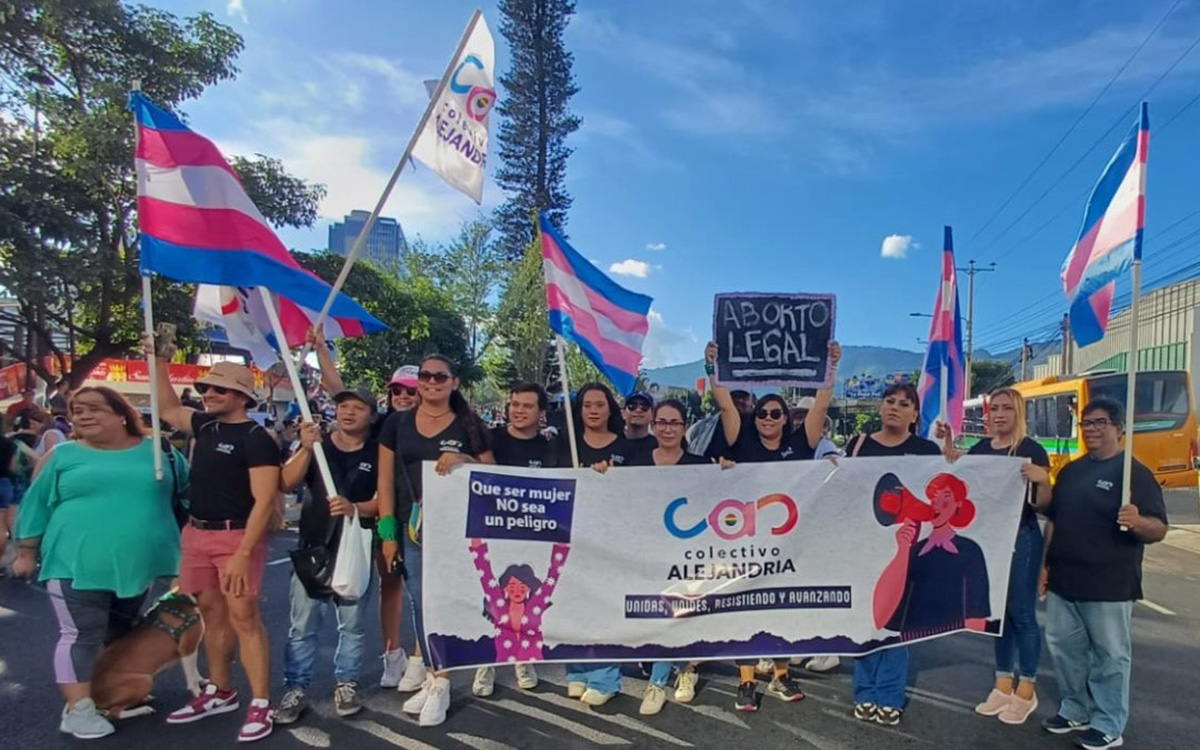
“My identity could be revealed, people can say whatever they want [online] without consequences. [Hormone replacement therapy] is illegal here so I’m just waiting to find a way to get out of here.”
-Anonymous respondent to the 2024 F&M Global Barometers LGBTQI+ Perception Index from Iraq, self-identified as a transgender woman and lesbian
As the campaign for 16 Days Against Gender-Based Violence begins, it is a reminder that gender-based violence (GBV) — both on– and offline — not only impacts women and girls but everyone who has been harmed or abused because of their gender or perceived gender. New research from the Franklin & Marshall (F&M) Global Barometers and its report A Growing Backlash: Quantifying the Experiences of LGBTQI+ People, 2022-2024 starkly show trends of declining safety among LGBTQI+ persons around the world.
This erosion of safety is accelerated by movements against gender equality and the disappearance of credible human rights data and reporting. The fight against GBV means understanding all people’s lived realities, including those of LGBTQI+ people, alongside the rights we continue to fight for.
We partnered together while at USAID and Franklin & Marshall College to expand the research and evidence base to better understand GBV against LGBTQI+ persons through the F&M Global Barometers. The collection of barometers tracks the legal rights and lived experiences of LGBTQI+ persons from 204 countries and territories from 2011 to the present. With more than a decade of data, it allows us to see how rights have progressed and receded as well as the gaps between legal protections and lived experiences of discrimination and violence.
This year’s data reveals alarming trends that highlight how fear and violence are, at its root, gendered phenomena that affect anyone who transgresses traditional gender norms.
LGBTQI+ people feel less safe
Nearly two-thirds of countries experienced a decline in their score on the F&M Global Barometers LGBTQI+ Perception Index (GBPI) from 2022-2024. This represents a five percent drop in global safety scores in just two years. With almost 70 percent of countries receiving an “F” grade on the GBPI, this suggests a global crisis in actual human rights protections for LGBTQI+ people.
Backsliding on LGBTQI+ human rights is happening everywhere, even in politically stable, established democracies with human rights protections for LGBTQI+ people. Countries in Western Europe and the Americas experienced the greatest negative GBPI score changes globally, 74 and 67 percent, respectively. Transgender people globally reported the highest likelihood of violence, while trans women and intersex people reported the highest levels of feeling very unsafe or unsafe simply because of who they are.
Taboo of gender equality
Before this current administration dismantled USAID, I helped create an LGBTQI+ inclusive whole-of-government strategy to prevent and respond to GBV that highlighted the unique forms of GBV against LGBTQI+ persons. This included so-called ‘corrective’ rape related to actual or perceived sexual orientation, gender identity, or expression” and so-called ‘conversion’ therapy practices that seek to change or suppress a person’s gender identity or expression, sexual orientation, or sex characteristics. These efforts helped connect the dots in understanding that LGBTQI+ violence is rooted in the same systems of inequality and power imbalances as the broader spectrum of GBV against women and girls.
Losing data and accountability
Data that helps better understand GBV against LGBTQI+ persons is also disappearing. Again, the dismantling of USAID meant a treasure trove of research and reports on LGBTQI+ rights have been lost. Earlier this year, the US Department of State removed LGBTQI+ reporting from its annual Human Rights Reports. These played a critical role in providing credible sources for civil society, researchers, and policymakers to track abuses and advocate for change.
If violence isn’t documented, it’s easier for governments to deny it even exists and harder for us to hold governments accountable. Yet when systems of accountability work, governments and civil society can utilize data in international forums like the UN Universal Periodic Review, the Convention on the Elimination of All Forms of Discrimination Against Women, and the Sustainable Development Goals to assess progress and compliance and call for governments to improve protections.
All may not be lost if other countries and donors fill the void by supporting independent data collection and reporting efforts like the F&M Global Barometers and other academic and civil society monitoring. Such efforts are essential to the fight against GBV: The data helps show that the path toward safety, equality, and justice is within our reach if we’re unafraid of truth and visibility of those most marginalized and impacted.
Jay Gilliam (he/him/his) was the Senior LGBTQI+ Coordinator at USAID and is a member of the Global Outreach Advisory Council of the F&M Global Barometers.
Susan Dicklitch-Nelson (she/her/hers) is the founder of the F&M Global Barometers and Professor of Government at Franklin & Marshall College.
Commentary
Second ‘lavender scare’ is harming our veterans. We know how to fix it
Out in National Security has built Trans Veterans State and Local Policy Toolkit

Seventy years after the first “lavender scare” drove LGBTQ Americans from public service, a second version is taking shape. Executive directives and administrative reviews have targeted transgender servicemembers and veterans, producing a new wave of quiet separations and lost benefits.
The policy language is technical, but the result is personal. Veterans who served honorably now face disrupted healthcare, delayed credentials, or housing barriers that no act of Congress ever required. Once again, Americans who met every standard of service are being told that their identity disqualifies them from stability.
Out in National Security built the Trans Veterans State and Local Policy Toolkit to change that. The toolkit gives state and local governments a practical path to repair harm through three measurable actions.
First, continuity of care. States can keep veterans covered by adopting presumptive Medicaid eligibility, aligning timelines with VA enrollment, and training providers in evidence-based gender-affirming care following the World Professional Association for Transgender Health Standards of Care Version 8.
Second, employment, and licensing. Governors and boards can recognize Department of Defense credentials, expedite licensing under existing reciprocity compacts, and ensure nondiscrimination in state veterans’ employment statutes.
Third, housing stability. States can designate transgender-veteran housing liaisons, expand voucher access, and enforce fair-housing protections that already exist in law.
Each step can be taken administratively within 90 days and requires no new federal legislation. The goal is straightforward: small, state-level reforms that yield rapid, measurable improvement in veterans’ daily lives.
The toolkit was introduced during a Veterans Week event hosted by the Center for American Progress, where federal and state leaders joined Out in National Security to highlight the first wave of state agencies adopting its recommendations. The discussion underscored how targeted, administrative reforms can strengthen veterans’ healthcare, employment, and housing outcomes without new legislation. Full materials and implementation resources are now available at outinnationalsecurity.org/public-policy/toolkit, developed in partnership with Minority Veterans of America, the Modern Military Association of America, SPARTA Pride, and the Human Rights Campaign.
These are technical fixes, but they carry moral weight. They reaffirm a basic democratic promise: service earns respect, not suspicion.
As a policy professional who has worked with veterans across the country, I see this moment as a test of civic integrity. The measure of a democracy is not only who it allows to serve but how it treats them afterward.
The second “lavender scare” will end when institutions at every level decide that inclusion is an obligation, not an exception. The toolkit offers a way to begin.
For more information or to access the toolkit once it is public, visit outinnationalsecurity.org/toolkit.
Lucas F. Schleusener is the CEO of Out in National Security.
-

 District of Columbia20 hours ago
District of Columbia20 hours agoBowser announces she will not seek fourth term as mayor
-

 U.S. Military/Pentagon1 day ago
U.S. Military/Pentagon1 day agoPentagon moves to break with Boy Scouts over LGBTQ and gender inclusion
-

 Drag2 days ago
Drag2 days agoPattie Gonia calls out Hegseth’s anti-LGBTQ policies — while doing better pull-ups
-

 District of Columbia3 days ago
District of Columbia3 days agoSecond gay candidate announces run for Ward 1 D.C. Council seat

